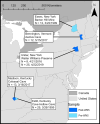Transcriptomic evidence of cytokine storm and sepsis in little brown bats exposed to white-nose syndrome
- PMID: 40599378
- PMCID: PMC12212055
- DOI: 10.1093/conphys/coaf040
Transcriptomic evidence of cytokine storm and sepsis in little brown bats exposed to white-nose syndrome
Abstract
Much progress has been made in understanding the pathophysiology of white-nose syndrome (WNS), a devastating disease that has impacted North American hibernating bats for nearly two decades. Growth of the causative fungal pathogen, Pseudogymnoascus destructans, on exposed epidermal tissue of bats creates an immune reaction that disrupts natural hibernation physiology and leads to premature expenditure of energy reserves and often death. Past work has highlighted the similarities between WNS and immune reconstitution inflammatory syndrome, but other conditions that have not been considered yet may also be relevant. We performed a transcriptomic analysis of wing tissue from naïve and exposed bats to further investigate the implications of observed differential gene expression patterns. For this analysis, we collected wing biopsy samples from 41 individuals prior to WNS emergence and 58 individuals 2-5 years after WNS emergence. We generated poly-A enriched tag-Seq libraries to compare gene expression between these groups. We then linked our findings and those of past studies to other disease systems to build hypotheses regarding mechanisms of WNS pathophysiology. We found an overrepresentation of functions related to programmed cell death and cytokine activity among upregulated genes. Importantly, we also identified upregulation of three S100 damage-associated molecular patterns (DAMPs) in exposed populations. Taken together, our findings and those of past studies suggest that infected bats experience a feedback loop of cell death among immune cells, the release of DAMPs and the stimulation of cytokine release that may act to maintain pathological immune activity. This feedback loop likely relates to cytokine storms in individuals with severe infection and possibly deteriorates into sepsis over time. Given the pathophysiology of sepsis, multiple organ dysfunction potentially contributes to the physiological disruption associated with WNS.
Keywords: Bats; Pseudogymnoascus destructans; gene expression; immune dysregulation; immune response; inflammation; pathophysiology.
© The Author(s) 2025. Published by Oxford University Press and the Society for Experimental Biology.
Conflict of interest statement
The authors have no conflicts of interest to declare.
Figures




Similar articles
-
Vulnerability of Southern Hemisphere bats to white-nose syndrome based on global analysis of fungal host specificity and cave temperatures.Conserv Biol. 2025 Apr;39(2):e14390. doi: 10.1111/cobi.14390. Epub 2024 Oct 15. Conserv Biol. 2025. PMID: 39403886 Free PMC article.
-
Survivor, family and professional experiences of psychosocial interventions for sexual abuse and violence: a qualitative evidence synthesis.Cochrane Database Syst Rev. 2022 Oct 4;10(10):CD013648. doi: 10.1002/14651858.CD013648.pub2. Cochrane Database Syst Rev. 2022. PMID: 36194890 Free PMC article.
-
Systemic pharmacological treatments for chronic plaque psoriasis: a network meta-analysis.Cochrane Database Syst Rev. 2017 Dec 22;12(12):CD011535. doi: 10.1002/14651858.CD011535.pub2. Cochrane Database Syst Rev. 2017. Update in: Cochrane Database Syst Rev. 2020 Jan 9;1:CD011535. doi: 10.1002/14651858.CD011535.pub3. PMID: 29271481 Free PMC article. Updated.
-
Factors that influence parents' and informal caregivers' views and practices regarding routine childhood vaccination: a qualitative evidence synthesis.Cochrane Database Syst Rev. 2021 Oct 27;10(10):CD013265. doi: 10.1002/14651858.CD013265.pub2. Cochrane Database Syst Rev. 2021. PMID: 34706066 Free PMC article.
-
Maternal and neonatal outcomes of elective induction of labor.Evid Rep Technol Assess (Full Rep). 2009 Mar;(176):1-257. Evid Rep Technol Assess (Full Rep). 2009. PMID: 19408970 Free PMC article.
References
-
- Barton, K., & Barton, M. K. (2015). Package ‘mumin’. Version, 1, 439.
LinkOut - more resources
Full Text Sources
Miscellaneous

